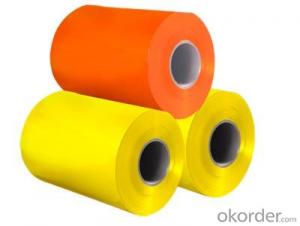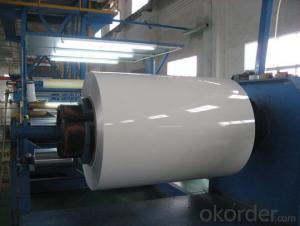6061 Aluminum Coil Price for AA1XXX Prepainted Aluminum Coils Used for Construction
- Loading Port:
- Shanghai
- Payment Terms:
- TT or LC
- Min Order Qty:
- 5 m.t.
- Supply Capability:
- 10000 m.t./month
OKorder Service Pledge
OKorder Financial Service
You Might Also Like
Specification
1.Structure of AA5xxx Prepainted Aluminum Coils Used for Construction Description
AA5xxx Prepainted Aluminum Coils Used for Construction are of a wide range of colors, which give wonderful appearance no matter in residential and commercial constructions or great exhibition centers.
AA5xxx Prepainted Aluminum Coils Used for Construction have been widely used in the fields of construction and decoration, electronic applications, lighting decoration, air-condition air pipes, sandwich panels and drainages etc.
2.Main Features of AA5xxx Prepainted Aluminum Coils Used for Construction
• Superior quality of raw material
• Reasonable and stable chemical composition
• Accurate tolerance
• Goode mechanical property
3.AA5xxx Prepainted Aluminum Coils Used for Construction Images



4.AA5xxx Prepainted Aluminum Coils Used for Construction Specification
| Alloy | AA1xxx,AA3xxx,AA5xxx |
| Temper | H14,H16,H18,H22,H24,H26,H32,O/F |
| Thickness | 0.03mm--3mm |
| Width | 30mm--1700mm |
| Coating | PE/PVDF/Exposy |
| Standard | B/T 17748-1999 |
5. FAQ of AA5xxx Prepainted Aluminum Coils Used for Construction
A.How to guarantee the quality?
Customers are welcome to our mill to visit and check the products. Besides, we can arrange a third party to test
AA5xxx Prepainted Aluminum Coils Used for Construction.
B.When will you deliver the products?
AA5xxx Prepainted Aluminum Coils Used for Construction will be delivered within 35 days after receiving advanced payment or original L/C.
- Q: How are aluminum coils processed to achieve desired mechanical properties?
- Aluminum coils are processed using various techniques to achieve the desired mechanical properties. One commonly used method is called annealing. Annealing is a heat treatment process in which the coils are heated to a specific temperature and then cooled slowly. This process helps to reduce internal stresses and improve the metal's ductility and toughness. Another important process is cold rolling. Cold rolling involves passing the coils through a series of rollers at room temperature to reduce their thickness and improve their mechanical properties. This process not only increases the strength of the aluminum but also enhances its surface finish. To further enhance the mechanical properties, aluminum coils can also undergo alloying. Alloying involves mixing the aluminum with other elements like copper, manganese, or magnesium to form specific alloys. These alloys offer improved strength, corrosion resistance, and other desirable properties. Additionally, aluminum coils can be subjected to heat treatments like precipitation hardening. This process involves heating the coils to a specific temperature and holding them there for a certain period, followed by rapid cooling. Precipitation hardening allows the metal's microstructure to form fine particles, which increase its strength and hardness. Lastly, surface treatments such as anodizing or painting can also be applied to aluminum coils to enhance their mechanical properties. Anodizing forms a protective oxide layer on the surface, improving corrosion resistance, while painting provides additional protection and aesthetic appeal. In summary, aluminum coils are processed through techniques such as annealing, cold rolling, alloying, heat treatments, and surface treatments to achieve the desired mechanical properties. These processes can enhance the strength, ductility, toughness, and corrosion resistance of the aluminum, making it suitable for a wide range of applications.
- Q: What are the potential hazards associated with handling aluminum coils?
- Handling aluminum coils comes with several potential hazards. One major concern is the risk of physical injury. Improper lifting or movement of the heavy coils can lead to strain or sprain injuries. Workers must handle them correctly to avoid such incidents. Furthermore, if the coils are not stacked or stored securely, they may fall and cause harm to workers. Another hazard associated with aluminum coils is the presence of sharp edges. Careless handling can result in cuts or lacerations from the coils' sharp edges or burrs. To minimize the risk of injury, workers should wear appropriate gloves and protective clothing. Another potential danger is the risk of fire or explosion. Aluminum is highly flammable when it comes into contact with certain substances, such as acids or alkalis. Therefore, it is crucial to store aluminum coils in a cool and dry place, away from any flammable materials. Moreover, aluminum coils pose a respiratory hazard. Manipulating or cutting them can release dust or particles into the air, which can cause respiratory irritation or even lung damage. Therefore, workers should wear appropriate respiratory protection when handling aluminum coils. Lastly, aluminum coils can also present a chemical hazard. Some aluminum coils may be coated or treated with chemicals that can be toxic or irritating to the skin and eyes. It is essential for workers to be aware of the specific hazards associated with the type of aluminum coil they are working with and take necessary precautions, such as wearing protective clothing and eye protection. Overall, workers must be aware of the potential hazards linked to aluminum coil handling and take appropriate safety measures to minimize risks. Regular training, proper lifting techniques, the use of protective equipment, and safe storage practices are all vital steps in ensuring the safety of workers who handle aluminum coils.
- Q: Do you have an aluminum coil first? Is there an aluminum plate?
- Yes, all aluminium sheets are made of aluminium rolls after slitting. The general process of aluminum plate production is: aluminium ingot - aluminum water - casting roll - aluminum roll ---- aluminum plate [Ji'nan excellent aluminum industry]. Welcome to visit.
- Q: Can aluminum coils be used in aerospace applications?
- Indeed, aerospace applications do make use of aluminum coils. The aerospace industry extensively utilizes aluminum due to its lightweight nature and impressive strength-to-weight ratio. Aircraft structures, including fuselages, wings, and landing gear, often incorporate aluminum coils. Moreover, heat transfer and cooling systems also benefit from their presence. The exceptional corrosion resistance and high thermal conductivity of aluminum coils render them fitting for diverse aerospace purposes. Furthermore, their malleability and ease of fabrication enable the creation of intricate shapes and designs necessary for aerospace components.
- Q: Can aluminum coils be used in high-magnetic field applications?
- Indeed, high-magnetic field applications can make use of aluminum coils. Being a non-magnetic material, aluminum lacks any magnetic properties, rendering it appropriate for such applications. This is particularly beneficial as the presence of a magnetic field could potentially disrupt the coils' performance or function. Consequently, aluminum coils find wide utilization across diverse industries, such as electrical engineering, aerospace, and automotive, all of which frequently encounter high-magnetic fields. Furthermore, aluminum boasts a lightweight nature and excellent electrical conductivity, making it an optimal selection for applications that necessitate efficient and lightweight coil designs.
- Q: I'm having trouble with another chem problemAluminum sulfide reacts w/water to form aluminum hydroxide and hydrogen sulfide. Write the balanced chemical equation for this reaction and find how many grams of aluminum hydroxide are obtained from 14.2 g of aluminum sulfide.I already found the balanced equation but I need help on finding how many grams of aluminum hydroxide are obtained from 14.2 g of aluminum sulfide. Can someone please explain how it's done?
- You use the given grams of Aluminum Sulfide, and use stoichiometry. First convert the Aluminum Sulfide from grams to moles [14.2g (1 mole of Aluminum Sulfide/total mass of Aluminum sulfide)]. Then, set up a mole ratio of Aluminum Sulfide to Aluminum Hydroxide (you do this by creating a ratio of the coefficients of both Aluminum Sulfide and Aluminum Hydroxide from your balanced equation; moles of Aluminum Hydroxide/miles of Aluminum Sulfide). And then finally convert back to grams (total mass of Aluminum Hydroxide/ 1 mole of Aluminum Hydroxide). In total, it should look like this: [14.2(1 mol Al Sulfide/mass of Al Sulfide)(mols of Al Hydroxide/mols of Al Sulfide)(mass of Al Hydroxide/1 mol of Al Hydroxide)]
- Q: What are the vibration damping properties of aluminum coils?
- Aluminum coils have excellent vibration damping properties, making them an ideal choice for various applications that require vibration control. Due to their high stiffness and low density, aluminum coils effectively absorb and dissipate vibrations, reducing the amplitude and frequency of oscillations. This vibration damping ability is beneficial in industries such as automotive, aerospace, and electronics, where minimizing vibration is crucial for performance, durability, and overall user experience. Additionally, aluminum coils' ability to dampen vibrations helps to reduce noise levels, leading to quieter operations and environments. Overall, aluminum coils' vibration damping properties contribute to improved product performance, increased safety, and enhanced user comfort.
- Q: My favorite deodorant contains aluminum. It smells really good and it works really well.My mom doesn't like me using it because it contains aluminum.So I got aluminum free. It doesn't smell at all (I can't seem to find fragrant aluminum free deodorant) and it doesn't work as well, for some reason.I want to keep using the one with aluminum, but will it be harmful to me in the future?
- i have tom deo. and it is totally safe, it is all organic stuff that you could like grow in your backyard. As apposed to chemical junk. kudoos to you for stopping with the anti-perspirants
- Q: Can aluminum coils be used in high-vibration environments?
- Indeed, high-vibration environments can accommodate the utilization of aluminum coils. Renowned for its remarkable strength-to-weight ratio, aluminum possesses the capacity to endure vibrations without undergoing substantial deformation or fracture. Moreover, its outstanding corrosion resistance characteristics render it suitable for diverse environmental circumstances. Consequently, it is frequently employed in sectors like automotive, aerospace, and electronics, where high-vibration environments prevail. Nevertheless, it is imperative to guarantee the appropriate design and installation of aluminum coils to mitigate any potential complications arising from vibration.
- Q: Aluminum coil area, with aluminum sheet area, how is not the same?
- Direct measurement length and width calculation area of aluminium plate;The aluminum coil can measure the volume of the aluminum coil and then calculate the area by dividing the thickness. You can also measure the mean diameter, calculate the perimeter, multiply the number of laps, the width, and calculate the area.
Send your message to us
6061 Aluminum Coil Price for AA1XXX Prepainted Aluminum Coils Used for Construction
- Loading Port:
- Shanghai
- Payment Terms:
- TT or LC
- Min Order Qty:
- 5 m.t.
- Supply Capability:
- 10000 m.t./month
OKorder Service Pledge
OKorder Financial Service
Similar products
Hot products
Hot Searches
Related keywords




























